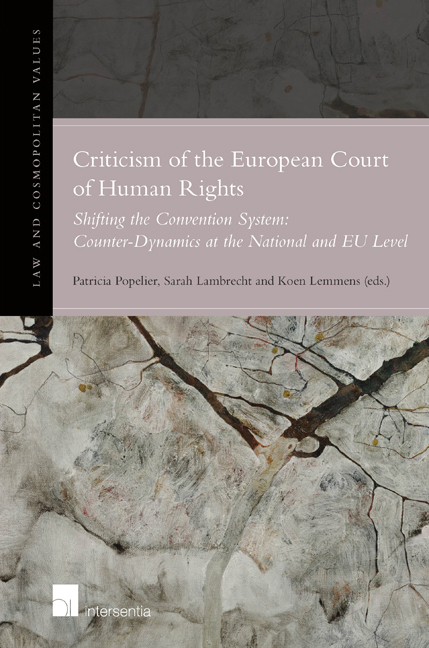 Criticism of the European Court of Human Rights
Criticism of the European Court of Human Rights from PART II - SPARSE CRITICISM
Published online by Cambridge University Press: 13 December 2017
CRITICISM OF THE EUROPEAN COURT OF HUMAN RIGHTS
The European Convention of Human Rights (ECHR) and the activity of its Court (ECtHR) are not very well covered by the Italian media. Actually Italian newspapers and the media frequently confuse the ECHR with EU law and, even more frequently, the ECtHR with the Court of Justice of the European Union (CJEU). This is emblematic of the very low level of the Italian media. Sometimes decisions delivered by the Luxembourg Court are attributed to the Strasbourg Court and vice versa. The situation is a bit better in the political world, although many politicians show not to know the difference between the two European Courts while the academia and the judiciary seem to be more used to the terminological ‘hidden dangers’ caused by the human rights architecture in Europe. There is no connection between the lack or presence of criticism and the status of the Convention and the ECtHR's judgments in the national legal system, although the degree of ‘invasiveness’ of the ECHR – especially after decisions n. 348 and 349/2007 of the Italian Constitutional Court (ICC) – is a factor which makes the decisions of the ECtHR more perceivable by the relevant actors, especially judges and political powers. There have been some exceptions to the impermeability of the media towards the activity of the ECtHR, probably the most important example in this respect is offered by the Lautsi saga. After Lautsi I many politicians reacted very badly, for instance Mariastella Gelmini – at that time Minister for Education – said the crucifix is a “symbol of our tradition”, and not a mark of Catholicism, Silvio Berlusconi – at that time ‘Prime Minister’ – defi ned Lautsi ‘not acceptable for us Italians. It is one of those decisions that make us doubt Europe's common sense’. However, the toughest reaction was that of Ignazio La Russa, at that time Minister for Defence, who said on TV – during a very popular talk show (‘La vita in diretta’):
Anyway, we won't take away the crucifix! They can die! The crucifix will remain in all schools’ rooms, in all public rooms! They can die! They can die! Them and those fake international organizations that count for nothing!
To save this book to your Kindle, first ensure no-reply@cambridge.org is added to your Approved Personal Document E-mail List under your Personal Document Settings on the Manage Your Content and Devices page of your Amazon account. Then enter the ‘name’ part of your Kindle email address below. Find out more about saving to your Kindle.
Note you can select to save to either the @free.kindle.com or @kindle.com variations. ‘@free.kindle.com’ emails are free but can only be saved to your device when it is connected to wi-fi. ‘@kindle.com’ emails can be delivered even when you are not connected to wi-fi, but note that service fees apply.
Find out more about the Kindle Personal Document Service.
To save content items to your account, please confirm that you agree to abide by our usage policies. If this is the first time you use this feature, you will be asked to authorise Cambridge Core to connect with your account. Find out more about saving content to Dropbox.
To save content items to your account, please confirm that you agree to abide by our usage policies. If this is the first time you use this feature, you will be asked to authorise Cambridge Core to connect with your account. Find out more about saving content to Google Drive.